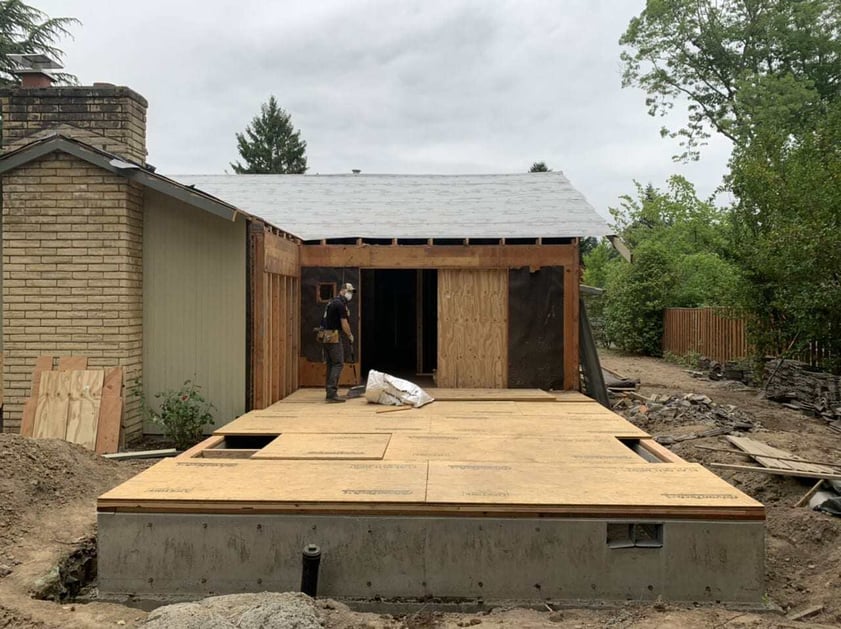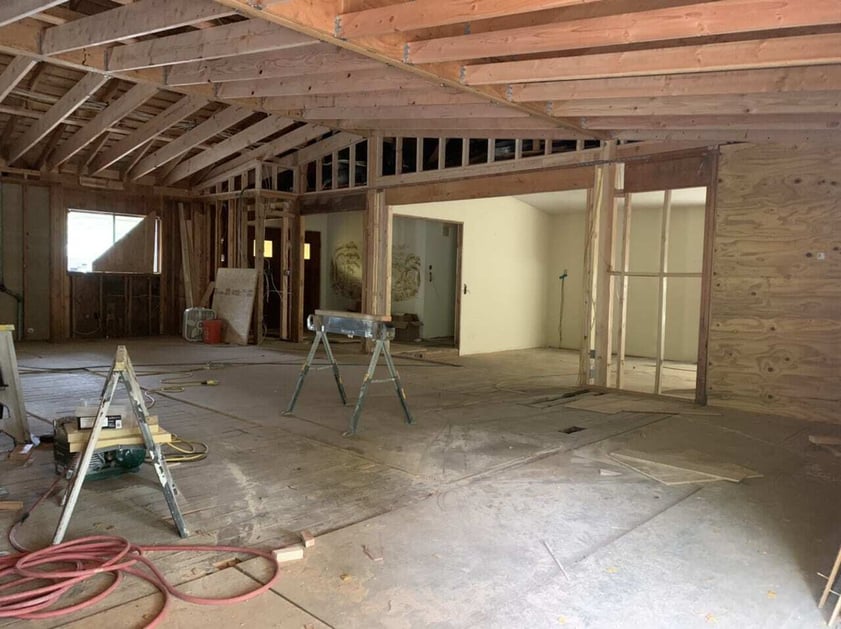Homeowners considering a full home renovation project often find themselves faced with a difficult decision: should the remodel be tackled all at once or approached in phases? This question isn’t just about managing disruptions or financial considerations. It’s deeply tied to the vision homeowners have for their homes and the challenges they’re prepared to face to see that vision come to life. Deciding whether to remodel all at once or in phases can impact the remodel timeline, cost, design consistency, and functionality.
Our team at Lamont Bros. Design & Construction is no stranger to these pivotal decisions homeowners face. As a renowned design-build remodeling firm, we’ve collaborated with hundreds of homeowners, each with unique needs and visions for their homes. These experiences have equipped us with the understanding required to weigh the benefits and challenges of both phased and full remodels, ensuring that each project aligns with a homeowner’s goals and constraints.
In this article, we aim to guide you through the intricacies of the two remodeling approaches: phased versus all-at-once. Whether you’re leaning towards a step-by-step transformation or a complete overhaul, the insights in this article will equip you with the knowledge to make an informed decision. The topics we’ll discuss include:
- What’s the Difference Between a Full & Phased Remodel?
- What Are the Pros and Cons of Each Option?
- How To Decide if You Should Remodel All at Once or in Phases
1. Overview of Phased vs. Full Remodel Processes
Before you can decide whether to phase your home remodel or do it all together, you first need to understand the difference between the two options and how they can affect your budget, lifestyle, and outcome.
Phased Remodel Process
Phased remodeling involves breaking down your renovation project into smaller, manageable phases. This can be a strategic approach that allows you to renovate different areas of the home piece by piece.
Each phase focuses on specific areas or aspects of your home. For example, you might start a phased home remodel by renovating your basement and then moving on to the kitchen and bathroom once that is completed.

Projects Suitable for Phased Remodeling
Phased remodeling is often used for major renovations like whole-home remodels, where the homeowner wants to remain in the home while gradually transforming it room by room or section by section.
Financing a Phased Remodel
In a phased remodel, homeowners budget for and secure financing for each phase separately. This means that instead of needing to secure funding for the entire project upfront, they can focus on one phase at a time.
However, this also means that each phase may be subject to different financing terms based on the condition of the market. If you plan to seek a loan for your remodel, recognize that financing a remodel in phases means you may risk ending up with less favorable loan terms down the road if the market changes for the worse. However, it’s also possible that the market changes for the better, resulting in lower interest rates for your future phases.
Remodeling All at Once
Rather than doing it in phases, you could remodel all at once in a single project. A full remodel is a comprehensive renovation where every aspect of the remodel is addressed as part of a single end-to-end process, resulting in a complete transformation.

Projects That Typically Require a Full Remodel
Full remodels are often necessary for homes needing urgent and extensive renovations where a definite and single process is more important to the homeowner than flexibility or keeping the home livable during renovations. This option also ensures that the final product has a cohesive, uniform design throughout the entire property.
Financing a Full Remodel
Mortgage lending for a full remodel usually involves securing a single renovation loan for the entire project. Because every aspect of the remodel falls into the same financing, it will require a larger upfront financial commitment.
However, choosing to remodel all at once rather than in phases comes with the added benefit of locking in your financing terms for the entire project. If the lending market improves and interest rates decrease, you can refinance later. However, having your entire remodel under one loan can save a lot of confusion while also reducing the financial risk associated with a changing economy.
2. What Are the Pros and Cons of Phased and Full Remodels?
Deciding whether to remodel all at once or in phases can be a difficult decision that depends on your specific circumstances. For some homeowners, the benefits of one option may outweigh the other.
Phased Remodeling
While offering more flexibility in terms of design and financing, phased remodeling may incur duplicate costs and carry more financial risk in general.
Pros of Phased Remodeling
- Flexibility in budgeting and financial planning: Phased remodeling allows you to distribute costs over time, making it easier to budget for each phase without the need for a significant upfront investment.
- Ability to adapt and change plans between phases: With phased remodeling, you have the flexibility to modify your design or scope between phases based on your evolving preferences or needs.
- Reduced need for temporary relocation: Phased remodeling often allows homeowners to remain in their homes during most of the project, minimizing the need for temporary relocations.

Cons of Phased Remodeling
- Possible duplication costs: Phasing your remodel might involve some duplication of costs, such as ordering multiple dumpsters for each phase or paying for additional inspections and permits that could be combined into one.
- The implications of annual cost increases in construction: Construction costs tend to rise over time. Phasing a project can lead to higher expenses in later phases due to these cost increases.
- Longer total project duration and extended disruptions: Phased remodeling can result in a longer overall project duration, extending the period of inconvenience associated with construction.
Remodeling All at Once
Full remodeling is a great option for homeowners who want a predictable project with a set trajectory, schedule, and cost. However, a full remodel is a much larger commitment and does reduce the amount of flexibility for the project once it begins.


Pros of Full Remodeling
- Consolidated costs and potential savings: A full remodel consolidates costs, potentially offering savings due to economies of scale and efficiency in project execution.
- Reduced total duration of inconvenience: With a full remodel, you experience a concentrated period of disruption but enjoy a shorter overall project timeline.
- Consistency in design and execution: An all-at-once remodel ensures uniformity in design and execution throughout your entire home.
Cons of Full Remodeling
- Larger upfront financial commitment: Full remodeling requires a substantial upfront financial commitment, which may be challenging for some homeowners.
- Necessity to relocate during extensive renovations: Depending on the scope of work, a full remodel may necessitate temporary relocation during the construction phase.
- Less flexibility for changes once the project starts: Once a full remodel is underway, significant changes to the design can be more complex and costly.
3. How to Decide if a Phased or Full Remodel is Best for You
Now that you understand the advantages and disadvantages of each option, you can begin to explore whether remodeling all at once or in phases is right for your home project.
3 Reasons to Remodel All at Once
- Achieve a consistent and holistic design vision: A full remodel allows you to create a cohesive, unified design concept that flows seamlessly throughout your entire home. If a consistent design aesthetic is important to you, a full remodel might be the way to go.
- Minimize total disruption by consolidating the construction timeline: While a full remodel involves intense disruption to your lifestyle during construction, it results in a shorter overall project duration than phased remodeling. If you’d rather get the project over and done with rather than deal with a longer, drawn-out process, you should remodel all at once.
- You want a predictable, locked-in financial plan for your project: Remodeling all at once allows you to secure a fixed-price contract for your entire project from start to finish. It also means you can fund the project under one renovation loan. That way, you get a fixed interest rate and loan terms that apply to the whole project.
3 Reasons to Do a Phased Remodel
- You want to be able to adjust budget and design between phases: Phased remodeling provides flexibility, allowing you to make changes to your project as you go along, adapting to your evolving needs. At the end of each phase, you can reevaluate your financial priorities and design style to further refine the vision before moving forward.
- You want to be able to evaluate and choose different contractors if needed: Between phases, you can assess the performance of your contractors and make informed decisions about continuing with them or seeking alternatives. Going this route also allows you to choose more specialized contractors for different types of projects, depending on what each phase involves.
- You don’t want to relocate during the renovations: Phased remodeling is more accommodating for homeowners who want to live in their homes during the project. Since only a part of the home is under construction at a given time, the rest of the home is available as living space, thus minimizing the inconvenience of temporary relocations.
Want to Learn More About Your Remodeling Options?
After reading this article, do you feel more confident in your understanding of the difference between remodeling all at once vs. in phases? Now that you’re equipped to make an informed decision for your home, take the next step in your remodeling journey. Download our free guide, “6 Steps to a Successful Remodel,” where we’ll walk you through a simple, proven process that will help you navigate your remodeling journey.
Think you’re ready to start remodeling your home? If so, click the button below to schedule a free design consultation with a member of our team. We’ll guide you through each step of the remodeling process so you can turn your current home into your dream home.



